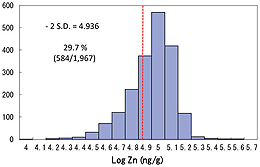Research Abstract
幼児期の亜鉛欠乏:自閉症スペクトラム障害との関連
Infantile zinc deficiency: Association with autism spectrum disorders
2011年11月3日 Scientific Reports 1 : 129 doi: 10.1038/srep00129

自閉症スペクトラム障害の発症機序の解明と有効な治療は、今日における挑戦的課題の1つである。本研究では、自閉症の子ども1,967人(男児1,553人、女児414人)を対象に頭髪の亜鉛濃度を調査し、亜鉛欠乏との間に注目すべき関連性があることを示す。頭髪の亜鉛濃度のヒストグラムは、低濃度域に裾をのばす非対称型の分布を示し、584人の被検者は、基準範囲(86.3~193 ppm)のマイナス2標準偏差値よりも低い亜鉛濃度を示した。0~3歳の幼児群での亜鉛欠乏の発生率は、男児でおよそ43.5%、女児でおよそ52.5%だった。最低亜鉛濃度の10.7 ppmは2歳の男児で見られ、これは基準平均値の約1/12に相当する。以上の知見は、幼児期の亜鉛欠乏が、自閉症の発症にエピジェネティックに関与する可能性と、栄養学的な取り組みによって、その治療と予防に対して新たな希望がもたらされる可能性を示唆している。
- ら・べるびぃ予防医学研究所
- 健康科学研究所
Elucidation of the pathogenesis and effective treatment of autism spectrum disorders is one of the challenges today. In this study, we examine hair zinc concentrations for 1,967 children with autistic disorders (1,553 males and 414 females), and show considerable association with zinc deficiency. Histogram of hair zinc concentration was non-symmetric with tailing in lower range, and 584 subjects were found to have lower zinc concentrations than -2 standard deviation level of its reference range (86.3–193 ppm). The incidence rate of zinc deficiency in infant group aged 0–3 year-old was estimated 43.5 % in male and 52.5 % in female. The lowest zinc concentration of 10.7 ppm was detected in a 2-year-old boy, corresponding to about 1/12 of the control mean level. These findings suggest that infantile zinc deficiency may epigenetically contribute to the pathogenesis of autism and nutritional approach may yield a novel hope for its treatment and prevention.

